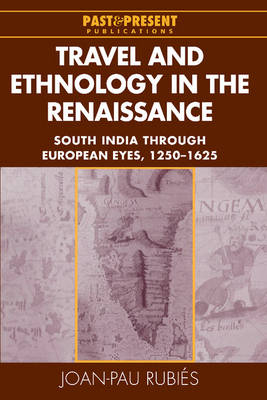
Travel and Ethnology in the Renaissance
South India through European Eyes, 1250–1625
Seiten
2000
Cambridge University Press (Verlag)
978-0-521-77055-2 (ISBN)
Cambridge University Press (Verlag)
978-0-521-77055-2 (ISBN)
This book, first published in 2000, is a major contribution to the study of the encounter between Europeans and non-Europeans in the early modern period and to a neglected aspect of the cultural transformation of Europe throughout the Renaissance. The book proposes a novel approach to the study of European attitudes towards non-Europeans.
This book, first published in 2000, offers a wide-ranging and ambitious analysis of how European travellers in India developed their perceptions of ethnic, political and religious diversity over three hundred years. It analyses the growth of novel historical and philosophical concerns, from the early and rare examples of medieval travellers such as Marco Polo, through to the more sophisticated narratives of seventeenth-century observers - religious writers such as Jesuit missionaries, or independent antiquarians such as Pietro della Valle. The book's approach combines the detailed contextual analysis of individual narratives with an original long-term interpretation of the role of cross-cultural encounters in the European Renaissance. An extremely wide range of European sources is discussed, including the often neglected but extremely important Iberian and Italian sources. However, the book also discusses a number of non-European sources, Muslim and Hindu, thereby challenging simplistic interpretations of western 'orientalism'.
This book, first published in 2000, offers a wide-ranging and ambitious analysis of how European travellers in India developed their perceptions of ethnic, political and religious diversity over three hundred years. It analyses the growth of novel historical and philosophical concerns, from the early and rare examples of medieval travellers such as Marco Polo, through to the more sophisticated narratives of seventeenth-century observers - religious writers such as Jesuit missionaries, or independent antiquarians such as Pietro della Valle. The book's approach combines the detailed contextual analysis of individual narratives with an original long-term interpretation of the role of cross-cultural encounters in the European Renaissance. An extremely wide range of European sources is discussed, including the often neglected but extremely important Iberian and Italian sources. However, the book also discusses a number of non-European sources, Muslim and Hindu, thereby challenging simplistic interpretations of western 'orientalism'.
Preface; 1. The search for India: the empire of Vijayanagara through European eyes; 2. Marco Polo's India and the Latin Christian tradition; 3. Establishing lay science: the merchant and the humanist; 4. The Portuguese and Vijayanagara: politics, religion and classification; 5. The practice of ethnography: Indian customs and castes; 6. The social and political order: Vijayanagara decoded; 7. The historical dimension: from native traditions to European orientalism; 8. The missionary discovery of South Indian religion: opening the doors of idolatry; 9. From humanism to scepticism: the independent traveller in the seventeenth century; 10. Conclusion: before orientalism; Appendix; Bibliography.
| Erscheint lt. Verlag | 21.12.2000 |
|---|---|
| Reihe/Serie | Past and Present Publications |
| Zusatzinfo | 12 Halftones, unspecified |
| Verlagsort | Cambridge |
| Sprache | englisch |
| Maße | 152 x 229 mm |
| Gewicht | 860 g |
| Themenwelt | Geschichte ► Allgemeine Geschichte ► Mittelalter |
| Geisteswissenschaften ► Geschichte ► Regional- / Ländergeschichte | |
| Sozialwissenschaften ► Soziologie | |
| ISBN-10 | 0-521-77055-6 / 0521770556 |
| ISBN-13 | 978-0-521-77055-2 / 9780521770552 |
| Zustand | Neuware |
| Haben Sie eine Frage zum Produkt? |
Mehr entdecken
aus dem Bereich
aus dem Bereich
eine neue Geschichte des Mittelalters
Buch | Hardcover (2023)
C.H.Beck (Verlag)
CHF 53,20


